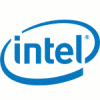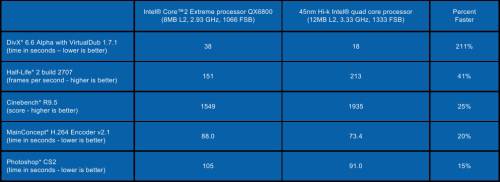- Qualcomm Launches Snapdragon 4 Gen 2 Mobile Platform
- AMD Launches Ryzen PRO 7000 Series Mobile & Desktop Platform
- Intel Launches Sleek Single-Slot Arc Pro A60 Workstation Graphics Card
- NVIDIA Announces Latest Ada Lovelace Additions: GeForce RTX 4060 Ti & RTX 4060
- Maxon Redshift With AMD Radeon GPU Rendering Support Now Available
Beijing IDF 07: Penryn, Teraflops and Skulltrail

IDF Beijing is now underway and there are countless announcements to cover. These include new Penryn performance reports, updated information on their 80-Core processor, a new teraflops technology called Larrabee, new power consumption goals and more.
Page 1 – Introduction, Goals, Penryn
|
|
The latest Intel Developer Forum is happening right now in Beijing and there are many new announcements to talk about. Though we are not in Beijing ourselves, we had a quick rundown about what’s being discussed there, so we will be relaying that information to you guys.
Intel has a few different accomplishments and new goals that they are stressing. First is that they are very proud of their new High-K MG transistors, which will allow exceptional efficiency and less voltage leakage. Because of this groundbreaking accomplishment, Intel notes that much more will be accomplished with their processors. We noted the potential of Nehalem a few weeks ago, primarily in regards to it’s potential for on-die additions, such as an integrated memory controller and even a GPU.
High-K, according to Intel, should not be taken lightly. It was said that this was the largest transistor accomplishment in the last forty years, and it’s effects should be felt by everyone. How this will affect anyone will be seen when our processors take advantage of the extra capabilities and on-die additions. Thanks to the much added efficiency, we will be seeing far better power consumption/usage.
This lead Intel to point out a few goals they have in mind. The first is for 10x power reduction, which they want to see happen by the end of this decade. That’s a large goal, and no doubt everyone wants to see it happen. We are on the road to see better power consumption as is, so to imagine a staggering decrease like 10x is amazing. There is little doubt that Intel is capable of this, since they’ve already produced very lightweight chips that have a lower than 10W TDP. Still, it will have to be seen.
Another goal has to do with their ongoing teraflops research. News spread like wildfire in February when they announced their 80-Core chip, for good reason. On day two, Intel will be showing off the chip and what it can do, although they will still not be giving away that much info at this point and time. You can expect them to hit at least 2 teraflops however, thanks to revisions of the chip.
On the topic of teraflops, Intel also announced Project Larrabee, which at this point is difficult to decipher. They did not disclose much information about it at all, but from what we could gather it will be marketed towards agencies that would benefit from teraflop operations without devoting an entire room to it. This could include medical, scientific, visualization, recognition and other applications that require unlimited power for quick computation time.
Whatever Larrabee turns out to be, its based on the IA programmable architecture to deploy applications, though current software tools can be used. The goal is to allow programs to exploit Larrabee to scale trillions of floating-point operations per second. As I said, not too much is really known about Larrabee at this point in time, but it will be one to watch.
Building on the success of their recently launched QX6800 processor, Intel also unveiled Skulltrail. Does anyone care what the technology is when the codename is that cool? Everyone? Ok then! Think AMD QuadFX, but for Intel Quad-Core processors. Yes, 8-Cores in your own personal rig, without it being a Xeon!
Current Q6600/Q6700 processor are not dual-socket capable, like high-end Xeons. Intel hasn’t confirmed that the QX6800 processor is at this point, but it’s assumed to be since they directly wrapped it into their announcement. This is bad for those who want to “low-end” Quad-Core processors to throw in their machines, but it’s the same way with AMD and their FX-74 processors. Be prepared to open your wallet should you want an 8-core system.
Intel touched on Penryn performance again, although the results are still very early. For their personal tests, they compared a current 2.93GHz Core QX6800 to a 45nm-based Penryn at 3.33GHz with 1333FSB with 12MB of cache. Right off the bat, this doesn’t seem to be much of a fair comparison given the fact there is a CPU frequency bump as well as FSB. However what it does tell us though, is that thanks to 45nm, we will indeed be seeing higher stock clock speeds over what Conroe currently offers.
At any rate, the results given are as follows:
- Unnamed 45nm 3.33GHz Quad-Core vs. QX6800 2.93GHz
- 15% faster for imaging-related applications
- 25% faster for 3-D rendering
- 40%+ faster for gaming
- 40%+ faster for video encoding utilizing SSE4
Like most scenarios today, we can see that Penryn won’t offer large performance increases for all applications, but can make huge differences for a select few. Video encoding and gaming showcased quite large differences. Applications they used included Half-Life 2 build 2707, Cinbench R9.5, MainConcept H.264 Encoder v2.1 and Photoshop CS2.
On the server side of things, you can expect up to 45% gains on bandwidth intensive applications (1333FSB Xeon) and 25% speed increases on Java-based servers (1600FSB Xeon).
That aside, I still find that a rather interesting comparison. It would have been more fair to compare two processors with equal frequencies, as I’m sure 3.33GHz will not be the lowest clocked Quad-Core in their Penryn line-up. Irregardless, it’s still too early to speculate that much, but these results give hope of undeniable gains.
|
|
Support our efforts! With ad revenue at an all-time low for written websites, we're relying more than ever on reader support to help us continue putting so much effort into this type of content. You can support us by becoming a Patron, or by using our Amazon shopping affiliate links listed through our articles. Thanks for your support!







